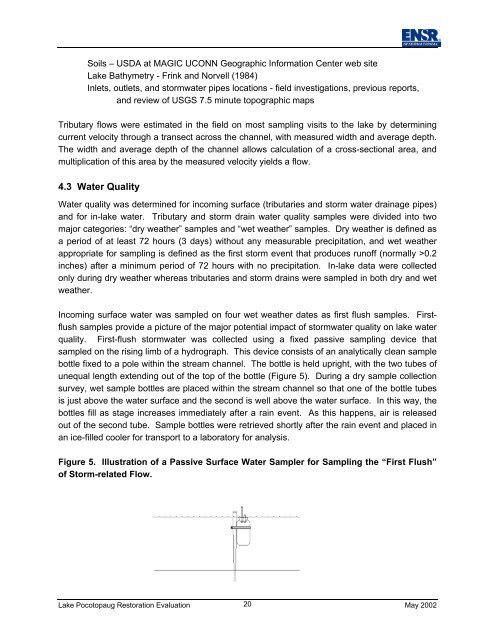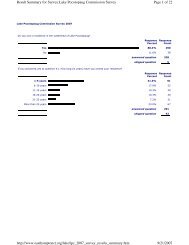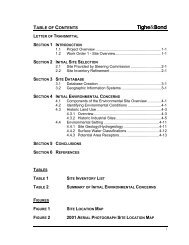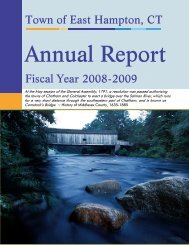Lake Pocotopaug Lake and Watershed Restoration Evaluation ...
Lake Pocotopaug Lake and Watershed Restoration Evaluation ...
Lake Pocotopaug Lake and Watershed Restoration Evaluation ...
Create successful ePaper yourself
Turn your PDF publications into a flip-book with our unique Google optimized e-Paper software.
Soils – USDA at MAGIC UCONN Geographic Information Center web site<strong>Lake</strong> Bathymetry - Frink <strong>and</strong> Norvell (1984)Inlets, outlets, <strong>and</strong> stormwater pipes locations - field investigations, previous reports,<strong>and</strong> review of USGS 7.5 minute topographic mapsTributary flows were estimated in the field on most sampling visits to the lake by determiningcurrent velocity through a transect across the channel, with measured width <strong>and</strong> average depth.The width <strong>and</strong> average depth of the channel allows calculation of a cross-sectional area, <strong>and</strong>multiplication of this area by the measured velocity yields a flow.4.3 Water QualityWater quality was determined for incoming surface (tributaries <strong>and</strong> storm water drainage pipes)<strong>and</strong> for in-lake water. Tributary <strong>and</strong> storm drain water quality samples were divided into twomajor categories: “dry weather” samples <strong>and</strong> “wet weather” samples. Dry weather is defined asa period of at least 72 hours (3 days) without any measurable precipitation, <strong>and</strong> wet weatherappropriate for sampling is defined as the first storm event that produces runoff (normally >0.2inches) after a minimum period of 72 hours with no precipitation. In-lake data were collectedonly during dry weather whereas tributaries <strong>and</strong> storm drains were sampled in both dry <strong>and</strong> wetweather.Incoming surface water was sampled on four wet weather dates as first flush samples. Firstflushsamples provide a picture of the major potential impact of stormwater quality on lake waterquality. First-flush stormwater was collected using a fixed passive sampling device thatsampled on the rising limb of a hydrograph. This device consists of an analytically clean samplebottle fixed to a pole within the stream channel. The bottle is held upright, with the two tubes ofunequal length extending out of the top of the bottle (Figure 5). During a dry sample collectionsurvey, wet sample bottles are placed within the stream channel so that one of the bottle tubesis just above the water surface <strong>and</strong> the second is well above the water surface. In this way, thebottles fill as stage increases immediately after a rain event. As this happens, air is releasedout of the second tube. Sample bottles were retrieved shortly after the rain event <strong>and</strong> placed inan ice-filled cooler for transport to a laboratory for analysis.Figure 5. Illustration of a Passive Surface Water Sampler for Sampling the “First Flush”of Storm-related Flow.<strong>Lake</strong> <strong>Pocotopaug</strong> <strong>Restoration</strong> <strong>Evaluation</strong> 20May 2002







